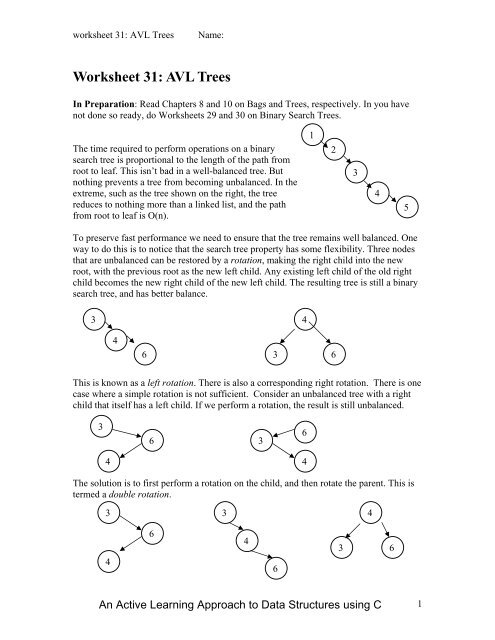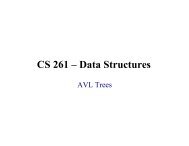Worksheet 31: AVL Trees - Classes
Worksheet 31: AVL Trees - Classes
Worksheet 31: AVL Trees - Classes
Create successful ePaper yourself
Turn your PDF publications into a flip-book with our unique Google optimized e-Paper software.
worksheet <strong>31</strong>: <strong>AVL</strong> <strong>Trees</strong><br />
Name:<br />
<strong>Worksheet</strong> <strong>31</strong>: <strong>AVL</strong> <strong>Trees</strong><br />
In Preparation: Read Chapters 8 and 10 on Bags and <strong>Trees</strong>, respectively. In you have<br />
not done so ready, do <strong>Worksheet</strong>s 29 and 30 on Binary Search <strong>Trees</strong>.<br />
The time required to perform operations on a binary<br />
search tree is proportional to the length of the path from<br />
root to leaf. This isn’t bad in a well-balanced tree. But<br />
nothing prevents a tree from becoming unbalanced. In the<br />
extreme, such as the tree shown on the right, the tree<br />
reduces to nothing more than a linked list, and the path<br />
from root to leaf is O(n).<br />
1<br />
2<br />
3<br />
4<br />
5<br />
To preserve fast performance we need to ensure that the tree remains well balanced. One<br />
way to do this is to notice that the search tree property has some flexibility. Three nodes<br />
that are unbalanced can be restored by a rotation, making the right child into the new<br />
root, with the previous root as the new left child. Any existing left child of the old right<br />
child becomes the new right child of the new left child. The resulting tree is still a binary<br />
search tree, and has better balance.<br />
3<br />
4<br />
4<br />
6<br />
3 6<br />
This is known as a left rotation. There is also a corresponding right rotation. There is one<br />
case where a simple rotation is not sufficient. Consider an unbalanced tree with a right<br />
child that itself has a left child. If we perform a rotation, the result is still unbalanced.<br />
3<br />
6<br />
3<br />
6<br />
4<br />
4<br />
The solution is to first perform a rotation on the child, and then rotate the parent. This is<br />
termed a double rotation.<br />
3<br />
3<br />
4<br />
4<br />
6<br />
4<br />
6<br />
3 6<br />
An Active Learning Approach to Data Structures using C 1
worksheet <strong>31</strong>: <strong>AVL</strong> <strong>Trees</strong><br />
Name:<br />
The data structure termed the <strong>AVL</strong> tree was designed using these ideas. The name honors<br />
the inventors of the data structure, the Russian mathematicians Georgii M. Adel'son-<br />
Vel'ski\u{\i} and Evgeni\u{\i} Mikha\u{\i}lovich Landis.<br />
In order to know when to perform a rotation, it is<br />
necessary to know the height of a node. We could<br />
calculate this amount, but that would slow the<br />
algorithm. Instead, we modify the Node so that each<br />
node keeps a record of its own height.<br />
struct <strong>AVL</strong>node {<br />
TYPE value;<br />
struct <strong>AVL</strong>node *left;<br />
struct <strong>AVL</strong>node *right;<br />
int height;<br />
};<br />
A function h(Node) will be useful to determine the height of a child node. Since leaf<br />
nodes have height zero, a value of -1 is returned for a null value. Using this, a function<br />
setHeight can be defined that will set the height value of a node, assuming that the height<br />
of the child nodes is known:<br />
int h(struct <strong>AVL</strong>node * current)<br />
{if (current == 0) return -1; return current->height;}<br />
void setHeight (struct <strong>AVL</strong>node * current) {<br />
int lch = h(current->left);<br />
int rch = h(current->right);<br />
if (lch < rch) current->height = 1 + rch;<br />
else current->height = 1 + lch;<br />
}<br />
Armed with the height information, the <strong>AVL</strong> tree algorithms are now easy to describe.<br />
The addition and removal algorithms for the binary search tree are modified so that their<br />
very last step is to invoke a method balance:<br />
struct <strong>AVL</strong>node * <strong>AVL</strong>nodeAdd (struct <strong>AVL</strong>node* current, TYPE newValue) {<br />
struct <strong>AVL</strong>node * newnode;<br />
if (current == 0) {<br />
newnode = (struct <strong>AVL</strong>node *) malloc(sizeof(struct <strong>AVL</strong>node));<br />
assert(newnode != 0);<br />
newnode->value = newValue;<br />
newnode->left = newnode->right = 0;<br />
return newnode; //why don’t we balance here ??<br />
} else if (LT(newValue, current->value))<br />
current->left = <strong>AVL</strong>nodeAdd(current->left, newValue);<br />
else current->right = <strong>AVL</strong>nodeAdd(current->right, newValue);<br />
return balance(current); /*
worksheet <strong>31</strong>: <strong>AVL</strong> <strong>Trees</strong><br />
Name:<br />
int bf (struct <strong>AVL</strong>node * current)<br />
{ return h(current->right) - h(current->left); }<br />
struct <strong>AVL</strong>node * balance (struct <strong>AVL</strong>node * current) {<br />
int cbf = bf(current);<br />
if (cbf < -1) {<br />
if (bf(current->left) > 0) // double rotation<br />
current->left = rotateLeft(current->left);<br />
return rotateRight(current); // single rotation<br />
} else if (cbf > 1) {<br />
if (bf(current->right) < 0)<br />
current->right = rotateRight(current->right);<br />
return rotateLeft(current);<br />
}<br />
setHeight(current);<br />
return current;<br />
}<br />
Since the balance function looks only at a node and its two children, the time necessary to<br />
perform rebalancing is proportional to the length of the path from root to leaf.<br />
Insert the values 1 to 7 into an empty <strong>AVL</strong> tree and show the resulting tree after each<br />
step. Remember that rebalancing is performed bottom up after a new value has been<br />
inserted, and only if the difference in heights of the child trees are more than two.<br />
An Active Learning Approach to Data Structures using C 3
worksheet <strong>31</strong>: <strong>AVL</strong> <strong>Trees</strong><br />
Name:<br />
Complete the implementation of the <strong>AVL</strong>tree abstraction by writing the methods to<br />
perform a left and right rotation. Both these methods should call setHeight on both the<br />
new interior node that has been changed and the new root. Other methods that are similar<br />
to those of the Binary Search Tree have been omitted:<br />
struct <strong>AVL</strong>node * rotateLeft (struct <strong>AVL</strong>node * current) {<br />
}<br />
struct <strong>AVL</strong>node * rotateRight (struct <strong>AVL</strong>node * current) {<br />
}<br />
Finally, let’s write the remove function for the <strong>AVL</strong> Tree. It is very similar to the<br />
remove() for a BST, however, you must be sure to balance when appropriate. We’ve<br />
provide the remove function, you must finish the implementation of the removeHelper.<br />
Assume you have access to removeLeftMost and LeftMost which we have already<br />
written for the BST.<br />
void remove<strong>AVL</strong>Tree(struct <strong>AVL</strong>Tree *tree, TYPE val) {<br />
if (contains<strong>AVL</strong>Tree(tree, val)) {<br />
tree->root = _removeNode(tree->root, val);<br />
tree->cnt--;<br />
}<br />
}<br />
TYPE _leftMost(struct <strong>AVL</strong>Node *cur) {<br />
while(cur->left != 0) {<br />
cur = cur->left;<br />
}<br />
return cur->val;<br />
}<br />
An Active Learning Approach to Data Structures using C 4
worksheet <strong>31</strong>: <strong>AVL</strong> <strong>Trees</strong><br />
Name:<br />
struct <strong>AVL</strong>Node *_removeLeftmost(struct <strong>AVL</strong>Node *cur) {<br />
struct <strong>AVL</strong>Node *temp;<br />
if(cur->left != 0)<br />
{<br />
cur->left = _removeLeftmost(cur->left);<br />
return _balance(cur);<br />
}<br />
}<br />
temp = cur->rght;<br />
free(cur);<br />
return temp;<br />
struct <strong>AVL</strong>Node *_removeNode(struct <strong>AVL</strong>Node *cur, TYPE val) {<br />
}<br />
An Active Learning Approach to Data Structures using C 5

















